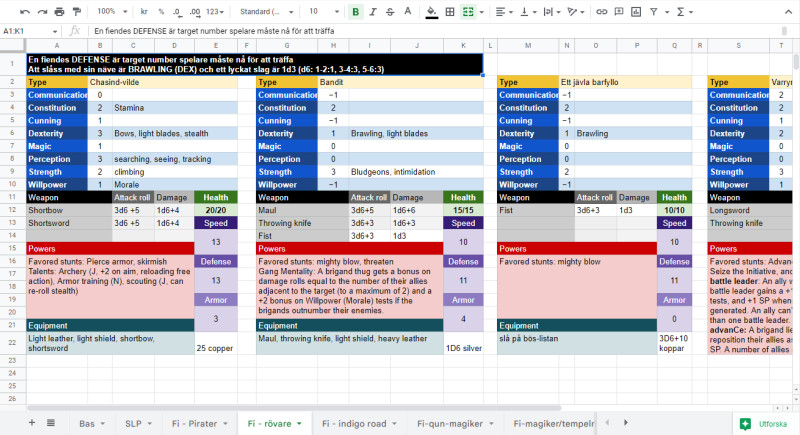This blog post series is about Game Mastering for TTRPGs – I’ve run some talks at various events about this topic, but thought it’d be nice to share my thoughts here on my blog. This fourth part will be about Planning your first session.
So, you have your players, you’ve chosen a game to play and you’ve had your first session zero. By this time you should know what kind of characters your players will play and what expectations they have. This is a prime time to start planning out your first session.
For me, it’s always easier to start planning if I have a deadline. So I’d recommend you and your players to decide on a date when you’ll play your first session. Otherwise you might end up in planning limbo and overplan and never feel ready for that first session.
The first session should be about exploring the characters, the rules and get a taste for the world and setting. Give your players some opportunities to both play their characters and roll some dice to test their skills, either by fights or other means – maybe your players want to just sneak past all enemies or talk their way to success. It doesn’t have to be perfect – it’s your first session, but rather a way to explore how it is to play and Game Master.
Should you write your own first adventure by yourself or use one that (hopefully) is included with your game? If you’re a bit stressed out by Game Mastering (because you already need to keep track of a lot of stuff), I’d say go for the pre-made adventure. When I started out Game Mastering Mutant:Year Zero, I looked at the pre-made adventure that came with the starter box and used that. If some things from the adventure really doesn’t work with your team, it’s totally fine to re-write it a little to fit your game a bit better (ie change location or some of the NPCs (Non-Playable Characters)). If the adventure is well written, you should have a lot of details about the setting(s), the characters the player will meet, the main plot and alternatives if the players stray off a bit. Read the adventure a couple of times, take some notes if you want to make changes and make it yours. Some games, like Mutant: Year Zero – Genlab Alpha is a whole campaign itself, so I pretty much just used that and made a few changes and additions to the game to fit my players’ characters a bit better.
By starting out using the pre-made adventures, I gained confidence to freestyle a little bit and make my own adventures for the players to enjoy. For the current game I’m running (Dragon Age), it’s pretty much my own material that I adapt depending on my players’ decisions. Thanks to the Dragon Age setting having a huge fanbase, it’s pretty easy to find material and lore connected to that world to use however I like.
After deciding on an adventure, it’s time to do some practical preparations. How do you keep track of the adventure and your NPCs? When I already have a pre-made adventure, it can feel pretty convenient to just look in the book (I mean, it’s allready written there), but depending on the book’s layout, I sometimes feel it’s easier to just collect it somewhere else. When I GM, I usually have an Ipad with Google Drive and Notion installed. I’ve tried Notion to keep track of my current game’s ideas for adventures, my player’s plots and so on, but using a Google Doc (or similar) is just as effective. I’m also using Google Sheets for my NPCs. It might not sound super hot, but I like that I can categorize my NPCs into tabs and have all the relevant NPCs in one place.

How you decide to keep track of your plots and NPCs is up to you, but I encourage you to have a system for it so you can easily access it whenever you need to. Maybe you prefer to have it on paper, or written down in a notebook, then make it so 🙂

Other things you might want to prepare before your first game are maps or visual aid for your players. You probably don’t need it for every scene, but if you’re planning on including a fight, an overview of where everyone is usually helps a little. It doesn’t have to super fancy, I usually just draw by hand and use meeples. If you want something more fancy (but still not minis and modeled landscapes), Dungeonfog is a tool where you can make maps and export them.
If you want to prepare even a bit further, you can plan out songs, or even playlists for your game! I created one for “normal play” and one for fights for my first game. If you play online, make sure you have a good way of playing the music. Roll20 and Foundry allows you to import and play some music (Roll20 already has some music and ambience pre-imported), and when you’re playing IRL, you can use any music service you like to play it. I’m using Spotify and cast it to an external speaker for my IRL games.
Hopefully, you now have some ideas of how to plan for your first session. Next time we’ll have a look at actually running your first session, see you then!
Leave a Reply